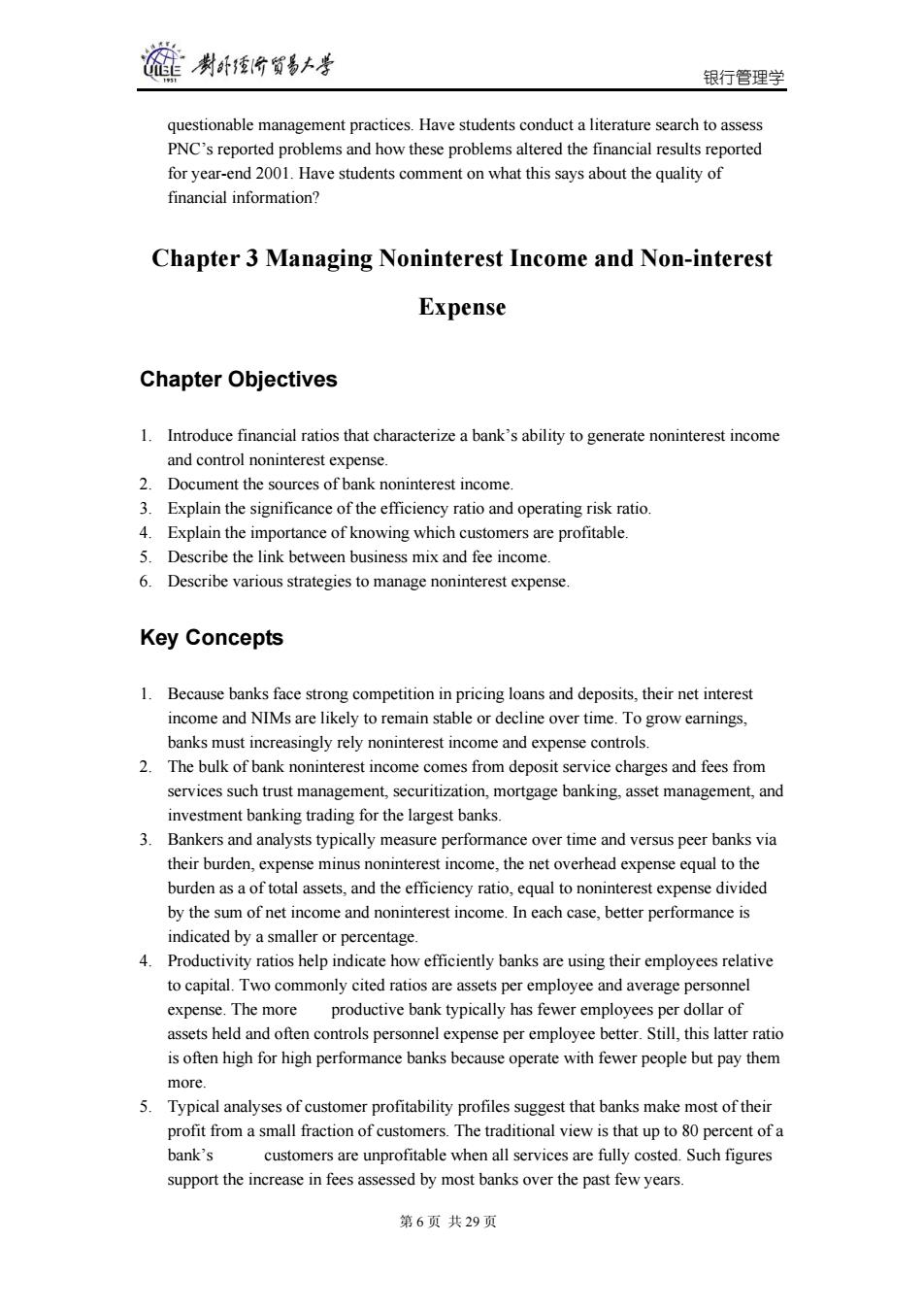
制卧台贸易上考 银行管理学 questionable management practices.Have students conduct a literature search to assess PNC's reported problems and how these problems altered the financial results reported for year-end 2001.Have students comment on what this says about the quality of financial information? Chapter 3 Managing Noninterest Income and Non-interest Expense Chapter Objectives 1.Introduce financial ratios that characterize a bank's ability to generate noninterest income and control noninterest expense 2.Document the sources of bank noninterest income. 3.Explain the significance of the efficiency ratio and operating risk ratio 4.Explain the importance of knowing which customers are profitable. 5.Describe the link between business mix and fee income. 6. Describe various strategies to manage noninterest expense. Key Concepts 1.Because banks face strong competition in pricing loans and deposits,their net interest income and NIMs are likely to remain stable or decline over time.To grow earnings, banks must increasingly rely noninterest income and expense controls. 2.The bulk of bank noninterest income comes from deposit service charges and fees from services such trust management,securitization,mortgage banking,asset management,and investment banking trading for the largest banks. 3.Bankers and analysts typically measure performance over time and versus peer banks via their burden,expense minus noninterest income,the net overhead expense equal to the burden as a of total assets,and the efficiency ratio,equal to noninterest expense divided by the sum of net income and noninterest income.In each case,better performance is indicated by a smaller or percentage. 4.Productivity ratios help indicate how efficiently banks are using their employees relative to capital.Two commonly cited ratios are assets per employee and average personnel expense.The more productive bank typically has fewer employees per dollar of assets held and often controls personnel expense per employee better.Still,this latter ratio is often high for high performance banks because operate with fewer people but pay them more. 5.Typical analyses of customer profitability profiles suggest that banks make most of their profit from a small fraction of customers.The traditional view is that up to 80 percent of a bank's customers are unprofitable when all services are fully costed.Such figures support the increase in fees assessed by most banks over the past few years. 第6页共29页
银行管理学 第 6 页 共 29 页 questionable management practices. Have students conduct a literature search to assess PNC’s reported problems and how these problems altered the financial results reported for year-end 2001. Have students comment on what this says about the quality of financial information? Chapter 3 Managing Noninterest Income and Non-interest Expense Chapter Objectives 1. Introduce financial ratios that characterize a bank’s ability to generate noninterest income and control noninterest expense. 2. Document the sources of bank noninterest income. 3. Explain the significance of the efficiency ratio and operating risk ratio. 4. Explain the importance of knowing which customers are profitable. 5. Describe the link between business mix and fee income. 6. Describe various strategies to manage noninterest expense. Key Concepts 1. Because banks face strong competition in pricing loans and deposits, their net interest income and NIMs are likely to remain stable or decline over time. To grow earnings, banks must increasingly rely noninterest income and expense controls. 2. The bulk of bank noninterest income comes from deposit service charges and fees from services such trust management, securitization, mortgage banking, asset management, and investment banking trading for the largest banks. 3. Bankers and analysts typically measure performance over time and versus peer banks via their burden, expense minus noninterest income, the net overhead expense equal to the burden as a of total assets, and the efficiency ratio, equal to noninterest expense divided by the sum of net income and noninterest income. In each case, better performance is indicated by a smaller or percentage. 4. Productivity ratios help indicate how efficiently banks are using their employees relative to capital. Two commonly cited ratios are assets per employee and average personnel expense. The more productive bank typically has fewer employees per dollar of assets held and often controls personnel expense per employee better. Still, this latter ratio is often high for high performance banks because operate with fewer people but pay them more. 5. Typical analyses of customer profitability profiles suggest that banks make most of their profit from a small fraction of customers. The traditional view is that up to 80 percent of a bank’s customers are unprofitable when all services are fully costed. Such figures support the increase in fees assessed by most banks over the past few years
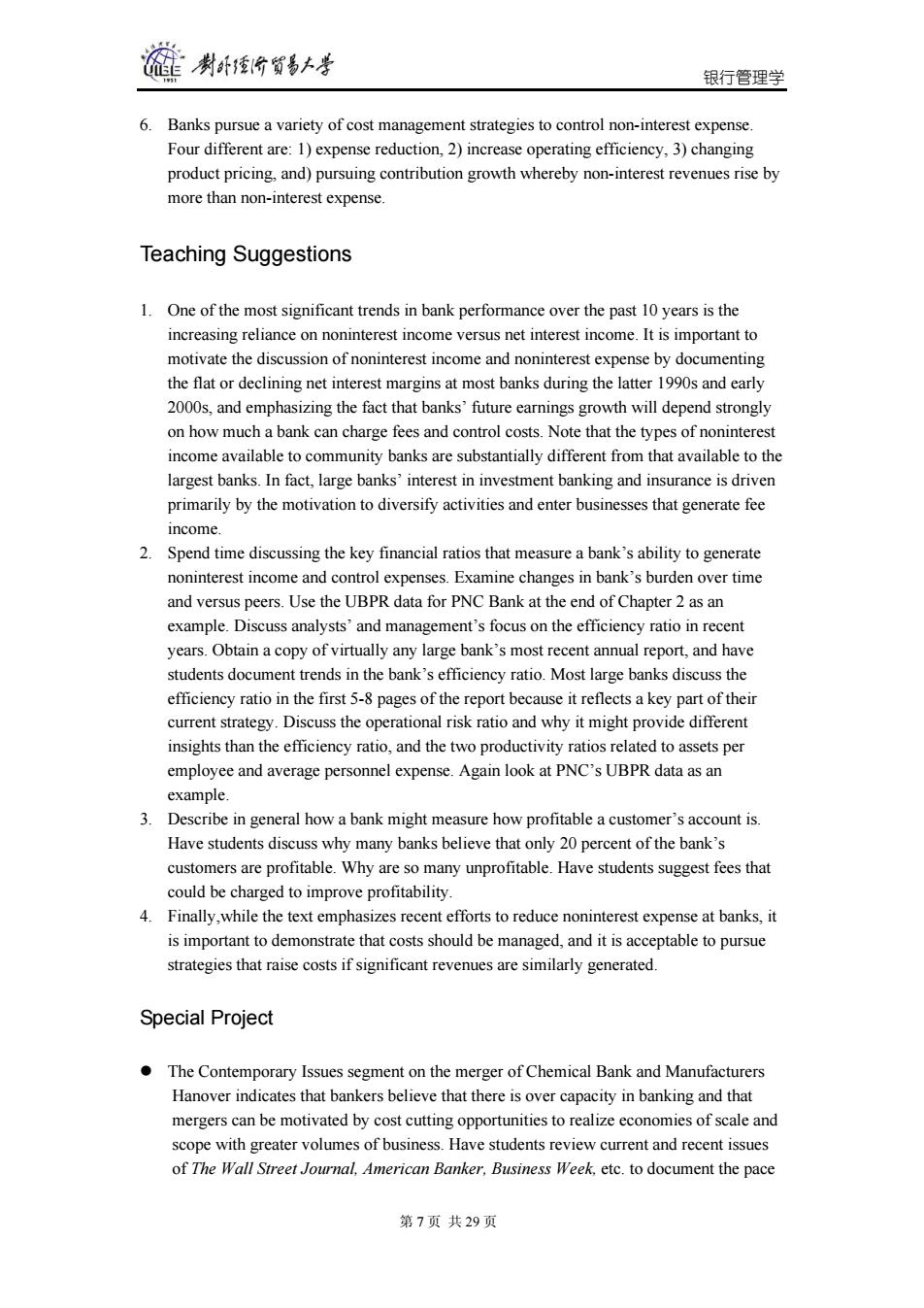
制卧台贸易上兰 银行管理学 6.Banks pursue a variety of cost management strategies to control non-interest expense. Four different are:1)expense reduction,2)increase operating efficiency,3)changing product pricing,and)pursuing contribution growth whereby non-interest revenues rise by more than non-interest expense Teaching Suggestions 1.One of the most significant trends in bank performance over the past 10 years is the increasing reliance on noninterest income versus net interest income.It is important to motivate the discussion of noninterest income and noninterest expense by documenting the flat or declining net interest margins at most banks during the latter 1990s and early 2000s,and emphasizing the fact that banks'future earnings growth will depend strongly on how much a bank can charge fees and control costs.Note that the types of noninterest income available to community banks are substantially different from that available to the largest banks.In fact,large banks'interest in investment banking and insurance is driven primarily by the motivation to diversify activities and enter businesses that generate fee income. 2.Spend time discussing the key financial ratios that measure a bank's ability to generate noninterest income and control expenses.Examine changes in bank's burden over time and versus peers.Use the UBPR data for PNC Bank at the end of Chapter 2 as an example.Discuss analysts'and management's focus on the efficiency ratio in recent years.Obtain a copy of virtually any large bank's most recent annual report,and have students document trends in the bank's efficiency ratio.Most large banks discuss the efficiency ratio in the first 5-8 pages of the report because it reflects a key part of their current strategy.Discuss the operational risk ratio and why it might provide different insights than the efficiency ratio,and the two productivity ratios related to assets per employee and average personnel expense.Again look at PNC's UBPR data as an example. 3.Describe in general how a bank might measure how profitable a customer's account is. Have students discuss why many banks believe that only 20 percent of the bank's customers are profitable.Why are so many unprofitable.Have students suggest fees that could be charged to improve profitability. 4.Finally,while the text emphasizes recent efforts to reduce noninterest expense at banks,it is important to demonstrate that costs should be managed,and it is acceptable to pursue strategies that raise costs if significant revenues are similarly generated. Special Project The Contemporary Issues segment on the merger of Chemical Bank and Manufacturers Hanover indicates that bankers believe that there is over capacity in banking and that mergers can be motivated by cost cutting opportunities to realize economies of scale and scope with greater volumes of business.Have students review current and recent issues of The Wall Street Journal,American Banker,Business Week,etc.to document the pace 第7页共29页
银行管理学 第 7 页 共 29 页 6. Banks pursue a variety of cost management strategies to control non-interest expense. Four different are: 1) expense reduction, 2) increase operating efficiency, 3) changing product pricing, and) pursuing contribution growth whereby non-interest revenues rise by more than non-interest expense. Teaching Suggestions 1. One of the most significant trends in bank performance over the past 10 years is the increasing reliance on noninterest income versus net interest income. It is important to motivate the discussion of noninterest income and noninterest expense by documenting the flat or declining net interest margins at most banks during the latter 1990s and early 2000s, and emphasizing the fact that banks’ future earnings growth will depend strongly on how much a bank can charge fees and control costs. Note that the types of noninterest income available to community banks are substantially different from that available to the largest banks. In fact, large banks’ interest in investment banking and insurance is driven primarily by the motivation to diversify activities and enter businesses that generate fee income. 2. Spend time discussing the key financial ratios that measure a bank’s ability to generate noninterest income and control expenses. Examine changes in bank’s burden over time and versus peers. Use the UBPR data for PNC Bank at the end of Chapter 2 as an example. Discuss analysts’ and management’s focus on the efficiency ratio in recent years. Obtain a copy of virtually any large bank’s most recent annual report, and have students document trends in the bank’s efficiency ratio. Most large banks discuss the efficiency ratio in the first 5-8 pages of the report because it reflects a key part of their current strategy. Discuss the operational risk ratio and why it might provide different insights than the efficiency ratio, and the two productivity ratios related to assets per employee and average personnel expense. Again look at PNC’s UBPR data as an example. 3. Describe in general how a bank might measure how profitable a customer’s account is. Have students discuss why many banks believe that only 20 percent of the bank’s customers are profitable. Why are so many unprofitable. Have students suggest fees that could be charged to improve profitability. 4. Finally,while the text emphasizes recent efforts to reduce noninterest expense at banks, it is important to demonstrate that costs should be managed, and it is acceptable to pursue strategies that raise costs if significant revenues are similarly generated. Special Project z The Contemporary Issues segment on the merger of Chemical Bank and Manufacturers Hanover indicates that bankers believe that there is over capacity in banking and that mergers can be motivated by cost cutting opportunities to realize economies of scale and scope with greater volumes of business. Have students review current and recent issues of The Wall Street Journal, American Banker, Business Week, etc. to document the pace
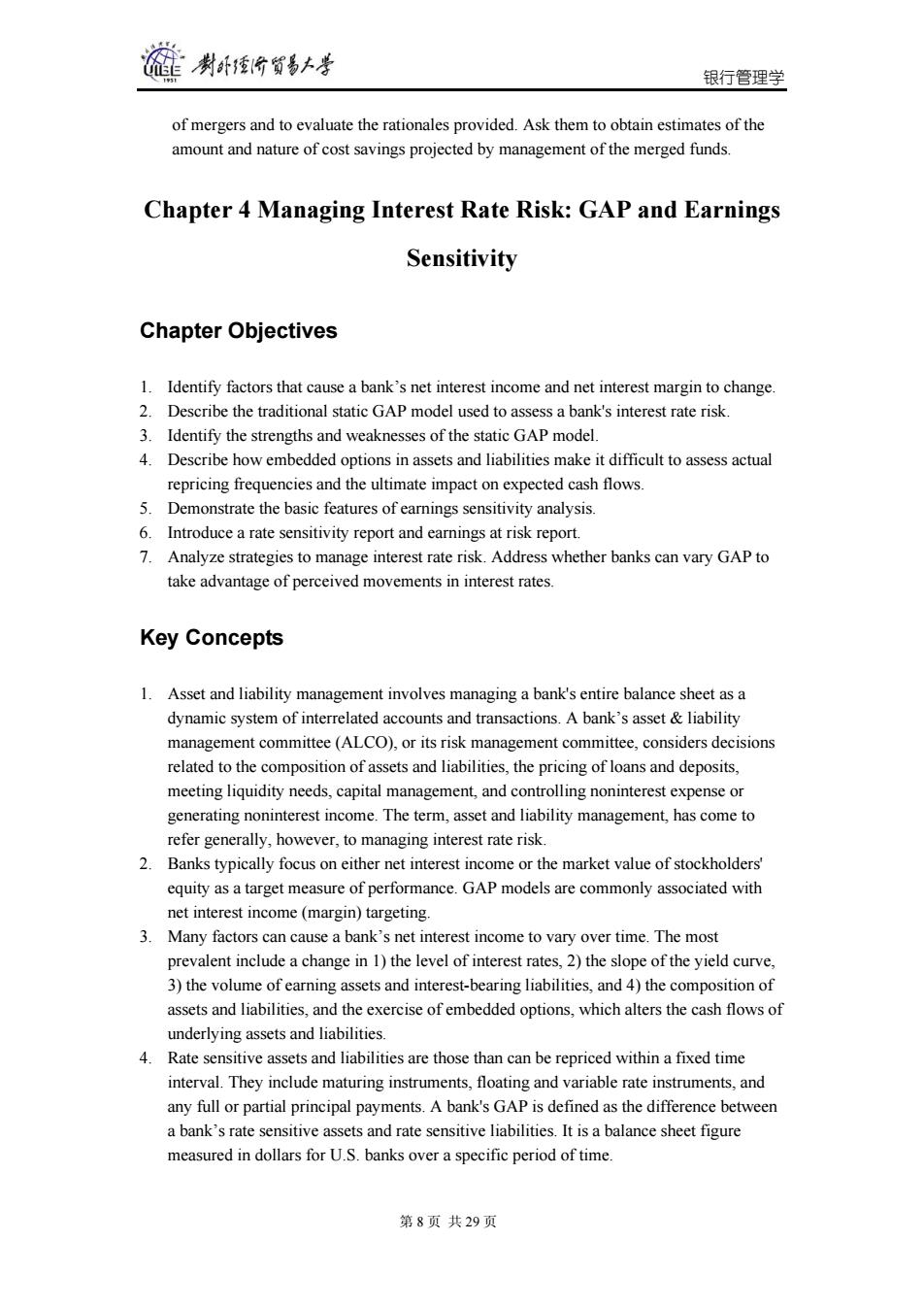
制卧价贸易上孝 银行管理学 of mergers and to evaluate the rationales provided.Ask them to obtain estimates of the amount and nature of cost savings projected by management of the merged funds. Chapter 4 Managing Interest Rate Risk:GAP and Earnings Sensitivity Chapter Objectives 1.Identify factors that cause a bank's net interest income and net interest margin to change. 2.Describe the traditional static GAP model used to assess a bank's interest rate risk. 3.Identify the strengths and weaknesses of the static GAP model. 4.Describe how embedded options in assets and liabilities make it difficult to assess actual repricing frequencies and the ultimate impact on expected cash flows. 5.Demonstrate the basic features of earnings sensitivity analysis. 6.Introduce a rate sensitivity report and earnings at risk report. 7.Analyze strategies to manage interest rate risk.Address whether banks can vary GAP to take advantage of perceived movements in interest rates. Key Concepts 1.Asset and liability management involves managing a bank's entire balance sheet as a dynamic system of interrelated accounts and transactions.A bank's asset liability management committee(ALCO),or its risk management committee,considers decisions related to the composition of assets and liabilities,the pricing of loans and deposits, meeting liquidity needs,capital management,and controlling noninterest expense or generating noninterest income.The term,asset and liability management,has come to refer generally,however,to managing interest rate risk. 2.Banks typically focus on either net interest income or the market value of stockholders' equity as a target measure of performance.GAP models are commonly associated with net interest income (margin)targeting. 3.Many factors can cause a bank's net interest income to vary over time.The most prevalent include a change in 1)the level of interest rates,2)the slope of the yield curve, 3)the volume of earning assets and interest-bearing liabilities,and 4)the composition of assets and liabilities,and the exercise of embedded options,which alters the cash flows of underlying assets and liabilities. 4.Rate sensitive assets and liabilities are those than can be repriced within a fixed time interval.They include maturing instruments,floating and variable rate instruments,and any full or partial principal payments.A bank's GAP is defined as the difference between a bank's rate sensitive assets and rate sensitive liabilities.It is a balance sheet figure measured in dollars for U.S.banks over a specific period of time. 第8页共29页
银行管理学 第 8 页 共 29 页 of mergers and to evaluate the rationales provided. Ask them to obtain estimates of the amount and nature of cost savings projected by management of the merged funds. Chapter 4 Managing Interest Rate Risk: GAP and Earnings Sensitivity Chapter Objectives 1. Identify factors that cause a bank’s net interest income and net interest margin to change. 2. Describe the traditional static GAP model used to assess a bank's interest rate risk. 3. Identify the strengths and weaknesses of the static GAP model. 4. Describe how embedded options in assets and liabilities make it difficult to assess actual repricing frequencies and the ultimate impact on expected cash flows. 5. Demonstrate the basic features of earnings sensitivity analysis. 6. Introduce a rate sensitivity report and earnings at risk report. 7. Analyze strategies to manage interest rate risk. Address whether banks can vary GAP to take advantage of perceived movements in interest rates. Key Concepts 1. Asset and liability management involves managing a bank's entire balance sheet as a dynamic system of interrelated accounts and transactions. A bank’s asset & liability management committee (ALCO), or its risk management committee, considers decisions related to the composition of assets and liabilities, the pricing of loans and deposits, meeting liquidity needs, capital management, and controlling noninterest expense or generating noninterest income. The term, asset and liability management, has come to refer generally, however, to managing interest rate risk. 2. Banks typically focus on either net interest income or the market value of stockholders' equity as a target measure of performance. GAP models are commonly associated with net interest income (margin) targeting. 3. Many factors can cause a bank’s net interest income to vary over time. The most prevalent include a change in 1) the level of interest rates, 2) the slope of the yield curve, 3) the volume of earning assets and interest-bearing liabilities, and 4) the composition of assets and liabilities, and the exercise of embedded options, which alters the cash flows of underlying assets and liabilities. 4. Rate sensitive assets and liabilities are those than can be repriced within a fixed time interval. They include maturing instruments, floating and variable rate instruments, and any full or partial principal payments. A bank's GAP is defined as the difference between a bank’s rate sensitive assets and rate sensitive liabilities. It is a balance sheet figure measured in dollars for U.S. banks over a specific period of time
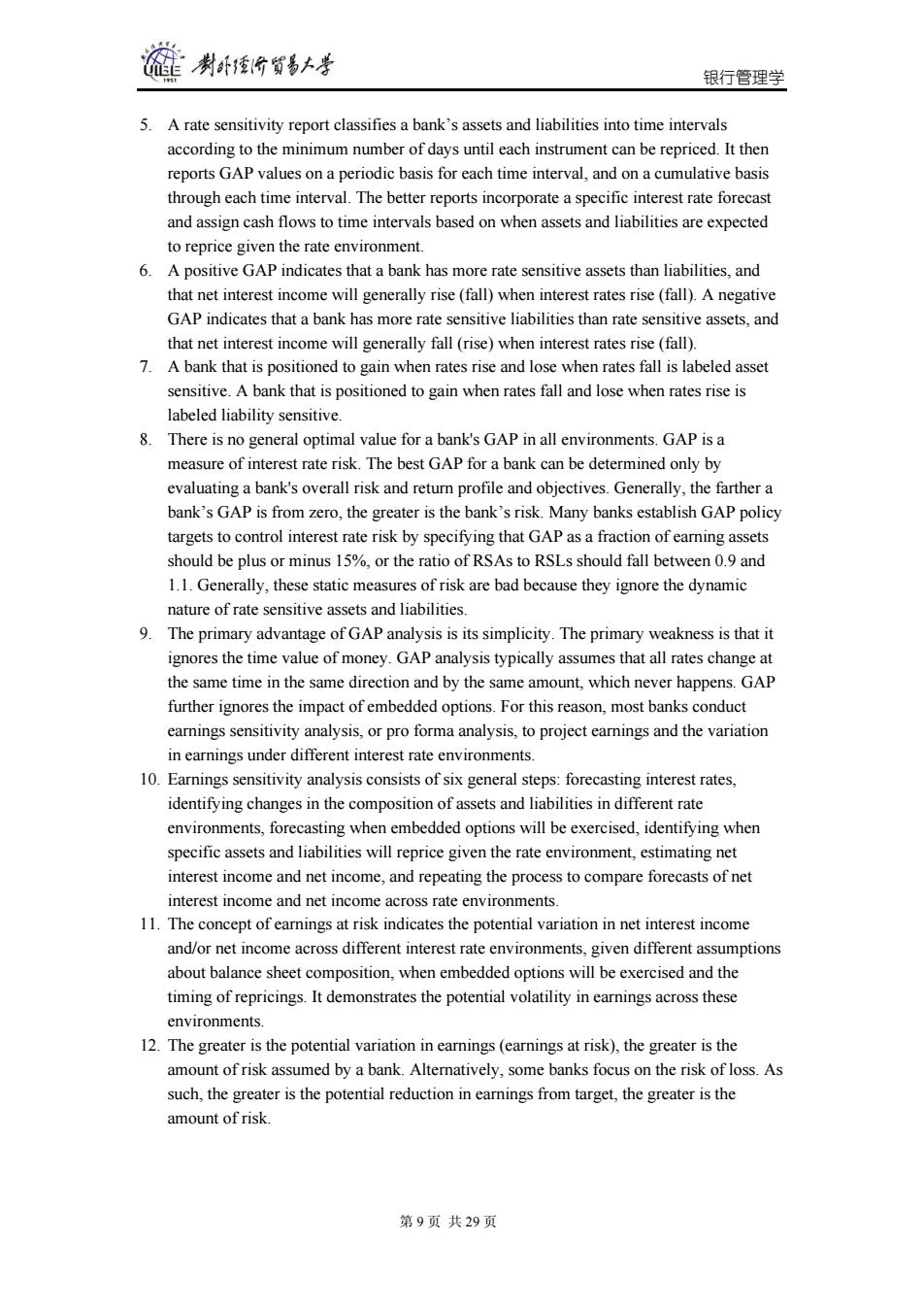
制卧台贸易上兰 银行管理学 5.A rate sensitivity report classifies a bank's assets and liabilities into time intervals according to the minimum number of days until each instrument can be repriced.It then reports GAP values on a periodic basis for each time interval,and on a cumulative basis through each time interval.The better reports incorporate a specific interest rate forecast and assign cash flows to time intervals based on when assets and liabilities are expected to reprice given the rate environment. 6.A positive GAP indicates that a bank has more rate sensitive assets than liabilities,and that net interest income will generally rise (fall)when interest rates rise (fall).A negative GAP indicates that a bank has more rate sensitive liabilities than rate sensitive assets,and that net interest income will generally fall(rise)when interest rates rise(fall). 7.A bank that is positioned to gain when rates rise and lose when rates fall is labeled asset sensitive.A bank that is positioned to gain when rates fall and lose when rates rise is labeled liability sensitive. 8.There is no general optimal value for a bank's GAP in all environments.GAP is a measure of interest rate risk.The best GAP for a bank can be determined only by evaluating a bank's overall risk and return profile and objectives.Generally,the farther a bank's GAP is from zero,the greater is the bank's risk.Many banks establish GAP policy targets to control interest rate risk by specifying that GAP as a fraction of earning assets should be plus or minus 15%,or the ratio of RSAs to RSLs should fall between 0.9 and 1.1.Generally,these static measures of risk are bad because they ignore the dynamic nature of rate sensitive assets and liabilities. 9.The primary advantage of GAP analysis is its simplicity.The primary weakness is that it ignores the time value of money.GAP analysis typically assumes that all rates change at the same time in the same direction and by the same amount,which never happens.GAP further ignores the impact of embedded options.For this reason,most banks conduct earnings sensitivity analysis,or pro forma analysis,to project earnings and the variation in earnings under different interest rate environments. 10.Earnings sensitivity analysis consists of six general steps:forecasting interest rates, identifying changes in the composition of assets and liabilities in different rate environments,forecasting when embedded options will be exercised,identifying when specific assets and liabilities will reprice given the rate environment,estimating net interest income and net income,and repeating the process to compare forecasts of net interest income and net income across rate environments. 11.The concept of earnings at risk indicates the potential variation in net interest income and/or net income across different interest rate environments,given different assumptions about balance sheet composition,when embedded options will be exercised and the timing of repricings.It demonstrates the potential volatility in earnings across these environments. 12.The greater is the potential variation in earnings(earnings at risk),the greater is the amount of risk assumed by a bank.Alternatively,some banks focus on the risk of loss.As such,the greater is the potential reduction in earnings from target,the greater is the amount of risk. 第9页共29页
银行管理学 第 9 页 共 29 页 5. A rate sensitivity report classifies a bank’s assets and liabilities into time intervals according to the minimum number of days until each instrument can be repriced. It then reports GAP values on a periodic basis for each time interval, and on a cumulative basis through each time interval. The better reports incorporate a specific interest rate forecast and assign cash flows to time intervals based on when assets and liabilities are expected to reprice given the rate environment. 6. A positive GAP indicates that a bank has more rate sensitive assets than liabilities, and that net interest income will generally rise (fall) when interest rates rise (fall). A negative GAP indicates that a bank has more rate sensitive liabilities than rate sensitive assets, and that net interest income will generally fall (rise) when interest rates rise (fall). 7. A bank that is positioned to gain when rates rise and lose when rates fall is labeled asset sensitive. A bank that is positioned to gain when rates fall and lose when rates rise is labeled liability sensitive. 8. There is no general optimal value for a bank's GAP in all environments. GAP is a measure of interest rate risk. The best GAP for a bank can be determined only by evaluating a bank's overall risk and return profile and objectives. Generally, the farther a bank’s GAP is from zero, the greater is the bank’s risk. Many banks establish GAP policy targets to control interest rate risk by specifying that GAP as a fraction of earning assets should be plus or minus 15%, or the ratio of RSAs to RSLs should fall between 0.9 and 1.1. Generally, these static measures of risk are bad because they ignore the dynamic nature of rate sensitive assets and liabilities. 9. The primary advantage of GAP analysis is its simplicity. The primary weakness is that it ignores the time value of money. GAP analysis typically assumes that all rates change at the same time in the same direction and by the same amount, which never happens. GAP further ignores the impact of embedded options. For this reason, most banks conduct earnings sensitivity analysis, or pro forma analysis, to project earnings and the variation in earnings under different interest rate environments. 10. Earnings sensitivity analysis consists of six general steps: forecasting interest rates, identifying changes in the composition of assets and liabilities in different rate environments, forecasting when embedded options will be exercised, identifying when specific assets and liabilities will reprice given the rate environment, estimating net interest income and net income, and repeating the process to compare forecasts of net interest income and net income across rate environments. 11. The concept of earnings at risk indicates the potential variation in net interest income and/or net income across different interest rate environments, given different assumptions about balance sheet composition, when embedded options will be exercised and the timing of repricings. It demonstrates the potential volatility in earnings across these environments. 12. The greater is the potential variation in earnings (earnings at risk), the greater is the amount of risk assumed by a bank. Alternatively, some banks focus on the risk of loss. As such, the greater is the potential reduction in earnings from target, the greater is the amount of risk
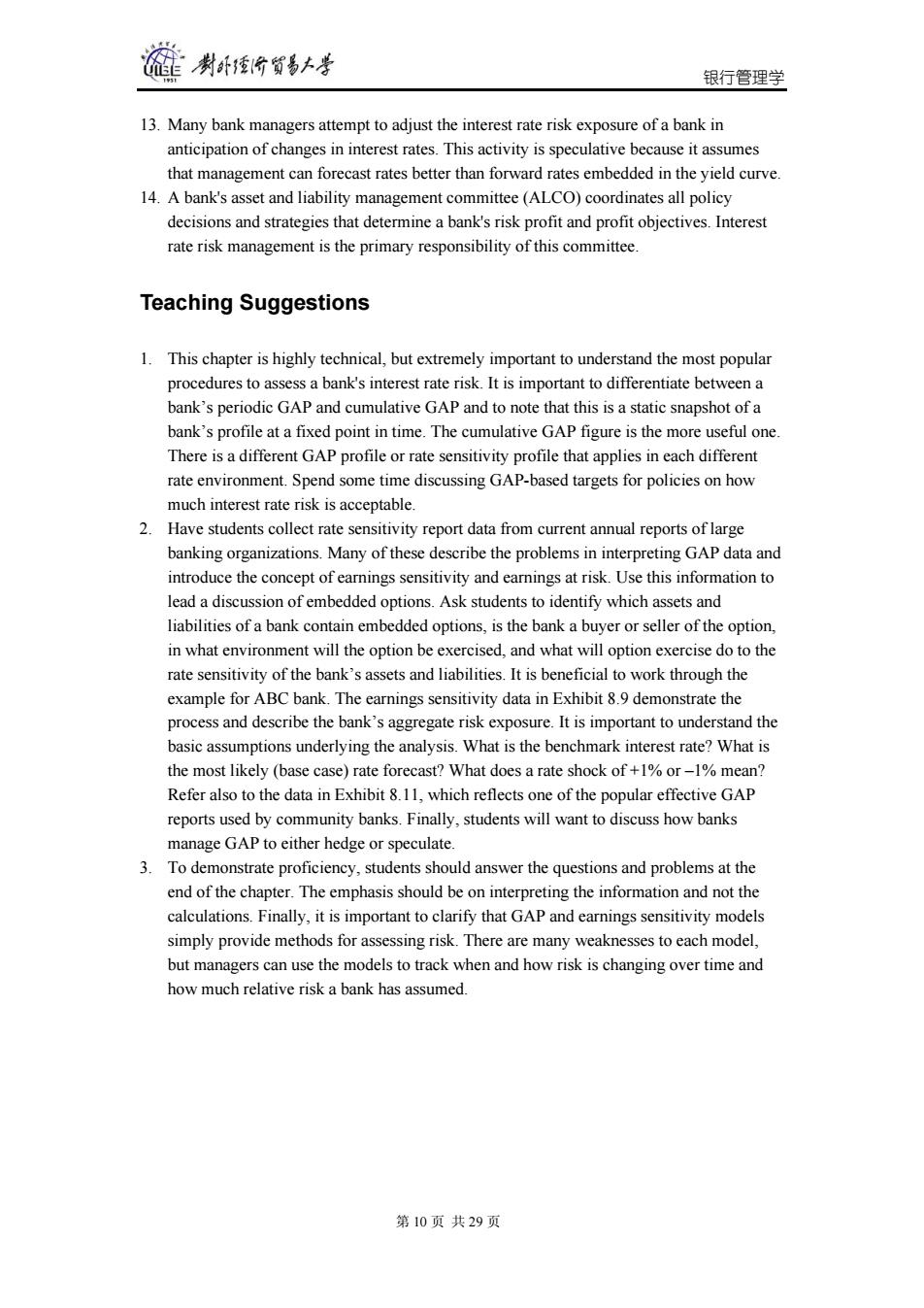
制卧台贸易上兰 银行管理学 13.Many bank managers attempt to adjust the interest rate risk exposure of a bank in anticipation of changes in interest rates.This activity is speculative because it assumes that management can forecast rates better than forward rates embedded in the yield curve. 14.A bank's asset and liability management committee (ALCO)coordinates all policy decisions and strategies that determine a bank's risk profit and profit objectives.Interest rate risk management is the primary responsibility of this committee. Teaching Suggestions 1.This chapter is highly technical,but extremely important to understand the most popular procedures to assess a bank's interest rate risk.It is important to differentiate between a bank's periodic GAP and cumulative GAP and to note that this is a static snapshot of a bank's profile at a fixed point in time.The cumulative GAP figure is the more useful one. There is a different GAP profile or rate sensitivity profile that applies in each different rate environment.Spend some time discussing GAP-based targets for policies on how much interest rate risk is acceptable. 2.Have students collect rate sensitivity report data from current annual reports of large banking organizations.Many of these describe the problems in interpreting GAP data and introduce the concept of earnings sensitivity and earnings at risk.Use this information to lead a discussion of embedded options.Ask students to identify which assets and liabilities of a bank contain embedded options,is the bank a buyer or seller of the option, in what environment will the option be exercised,and what will option exercise do to the rate sensitivity of the bank's assets and liabilities.It is beneficial to work through the example for ABC bank.The earnings sensitivity data in Exhibit 8.9 demonstrate the process and describe the bank's aggregate risk exposure.It is important to understand the basic assumptions underlying the analysis.What is the benchmark interest rate?What is the most likely (base case)rate forecast?What does a rate shock of +1%or-1%mean? Refer also to the data in Exhibit 8.11,which reflects one of the popular effective GAP reports used by community banks.Finally,students will want to discuss how banks manage GAP to either hedge or speculate. 3.To demonstrate proficiency,students should answer the questions and problems at the end of the chapter.The emphasis should be on interpreting the information and not the calculations.Finally,it is important to clarify that GAP and earnings sensitivity models simply provide methods for assessing risk.There are many weaknesses to each model, but managers can use the models to track when and how risk is changing over time and how much relative risk a bank has assumed. 第10页共29页
银行管理学 第 10 页 共 29 页 13. Many bank managers attempt to adjust the interest rate risk exposure of a bank in anticipation of changes in interest rates. This activity is speculative because it assumes that management can forecast rates better than forward rates embedded in the yield curve. 14. A bank's asset and liability management committee (ALCO) coordinates all policy decisions and strategies that determine a bank's risk profit and profit objectives. Interest rate risk management is the primary responsibility of this committee. Teaching Suggestions 1. This chapter is highly technical, but extremely important to understand the most popular procedures to assess a bank's interest rate risk. It is important to differentiate between a bank’s periodic GAP and cumulative GAP and to note that this is a static snapshot of a bank’s profile at a fixed point in time. The cumulative GAP figure is the more useful one. There is a different GAP profile or rate sensitivity profile that applies in each different rate environment. Spend some time discussing GAP-based targets for policies on how much interest rate risk is acceptable. 2. Have students collect rate sensitivity report data from current annual reports of large banking organizations. Many of these describe the problems in interpreting GAP data and introduce the concept of earnings sensitivity and earnings at risk. Use this information to lead a discussion of embedded options. Ask students to identify which assets and liabilities of a bank contain embedded options, is the bank a buyer or seller of the option, in what environment will the option be exercised, and what will option exercise do to the rate sensitivity of the bank’s assets and liabilities. It is beneficial to work through the example for ABC bank. The earnings sensitivity data in Exhibit 8.9 demonstrate the process and describe the bank’s aggregate risk exposure. It is important to understand the basic assumptions underlying the analysis. What is the benchmark interest rate? What is the most likely (base case) rate forecast? What does a rate shock of +1% or –1% mean? Refer also to the data in Exhibit 8.11, which reflects one of the popular effective GAP reports used by community banks. Finally, students will want to discuss how banks manage GAP to either hedge or speculate. 3. To demonstrate proficiency, students should answer the questions and problems at the end of the chapter. The emphasis should be on interpreting the information and not the calculations. Finally, it is important to clarify that GAP and earnings sensitivity models simply provide methods for assessing risk. There are many weaknesses to each model, but managers can use the models to track when and how risk is changing over time and how much relative risk a bank has assumed